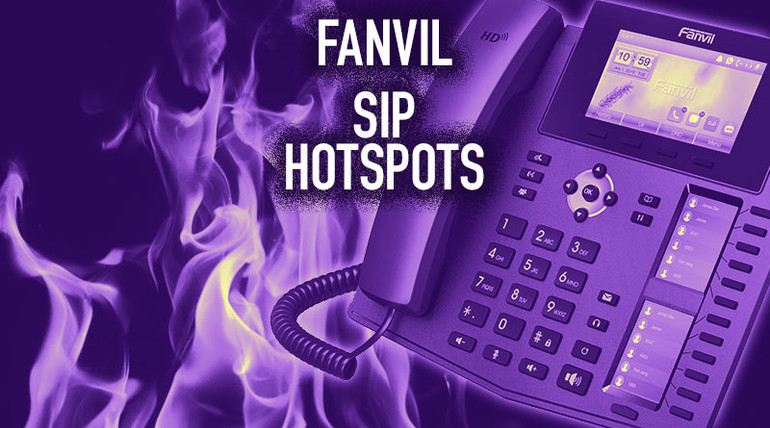With SIP hotspots, Fanvil gives you a method to simplify managing your VoIP phones.
Most people are familiar with hotspots on smartphones.
When you use a cellular hotspot with a smartphone, one phone connects to the cellular network and additional phones connect to the first phone. The data used is all through the first phone.
It’s the same idea with Fanvil SIP phones. You set up a SIP extension on one phone. Then you set additional phones to act as clients of the first phone. The additional phones don’t require separate extensions.
When a call comes in, all the phones ring and you can answer from any phone. Or you can place a call from any phone.
In either case, the VoIP phone system interprets the call as coming from the extension of the initial phone. You can transfer calls between the hotspot phones.
The phones don’t need to be cabled directly to each other. They just need to be part of the same VoIP phone network.
Currently, the hotspot feature is only supported by Fanvil X Series IP Phones like Fanvil X6 and Fanvil H Series IP Hotel Phones like Fanvil H3.

Scenarios for SIP Hotspots
When would you use SIP hotspots on Fanvil phones? Here are some scenarios.
- Offices in Different Locations
- Hotspots for Hotel Rooms
- Keeping in Touch in the SOHO
Offices in Different Locations
One of the fabulous features of VoIP is that you can have a single, unified phone system even if your offices are located on opposite coasts of the US.
So picture this:
You’re an engineer with a midsize business that’s opening up a new building in the suburbs to better serve customers. Your company wants you to have offices at both buildings, as makes sense. It’s a growing business, and you’re in high demand.
Fanvil SIP hotspots simplify this arrangement, so your admin only needs to set one extension for the phone in both offices. They’ll both ring, and you can pick up whichever phone you’re near at the time.
Simple as that.

Hotspots for Hotel Rooms
Fanvil IP hotel phones are incredibly cost-effective. Using SIP hotspots, they become that much more powerful.
Let’s say you’re setting up hotel rooms. Each room has a kitchenette and a lounge, in addition to a bedroom and working space. Some are aimed at romantic couples, some at families. Multiple phones are called for, one at the working desk, one in the lounge, say.
In either case, you’ll want to make calling room service or calling out as effortless as possible. It’s one of those features that might improve customer experience, netting your hotel more positive reviews, better word of mouth. “Convenient.” “Thoughtful.” “Excellent service.”
Now, even if having multiple phones in a single hotel room is a great idea, you don’t need to have separate lines. You also want to keep costs down.
With Fanvil hotspots, you only need a single extension for each room. The customer can use whichever handset they want in the room, and in your system it’ll appear as coming from one extension like “Room 237.”
It simplifies both the customer’s experience and your own phone system.
Keeping Touch in the SOHO
Fanvil hotspots also work brilliantly for SOHO (small office, home office) phones.
You need to always be in touch. But in the home office, you might also need to grab food from the kitchen, check on the dog or the baby, go out to the garage that you’ve made into a creative space. You know all the little things that can come up.
Same goes for the small office. You need to be near a phone. You don’t have nearly the luxury of cover that you find in the big leagues.
Configuring a Fanvil SIP hotspot reduces expenditures — you might only need a single extension — while enabling you to maintain phone coverage for wherever you want in the house or small office.
Put a phone in the office, the garage, the kitchen. Set one to work as a hotspot and the others as clients of the hotspot. Whenever a call comes in, you can answer it at any phone.

